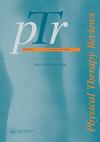肌肉骨骼疾病管理中的远程康复与面对面康复:一项系统综述和荟萃分析
IF 0.8
Q4 REHABILITATION
引用次数: 1
摘要
背景:在世界范围内,脊柱疼痛和骨关节炎等肌肉骨骼疾病是导致残疾的主要原因。随着COVID-19大流行迫使许多医疗保健提供者改变慢性病护理的提供方式,远程医疗是面对面咨询的替代方案,可用于评估和提供治疗和支持。识别、评估和综合所有随机对照试验(rct)的结果,这些试验比较了患有任何类型肌肉骨骼疾病的患者的远程医疗和面对面咨询。方法系统回顾和荟萃分析。我们使用GRADE方法来评估与所有结果相关的证据质量。我们检索了三个电子数据库(PubMed、Embase、CENTRAL)、临床试验注册库和纳入研究的引用参考文献。结果纳入5项随机对照试验:1例膝关节骨性关节炎患者,1例膝关节或髋关节骨性关节炎患者准备全关节镜检查,3例全膝关节置换术后。远程医疗在四次试验中通过视频进行,在一次试验中通过电话进行。五项试验共分析了402名参与者。远程医疗和面对面治疗在干预后立即的疼痛结局(WOMAC)方面没有显著差异(平均差异(MD): 0.12 (95% CI:−2.3至2.6,p = 0.92),干预后两个月(MD): 1.2, (95% CI:−2.7至5.1,p = 0.55)。同样,干预后两种分娩方式在功能、生活质量和满意度方面的相关结果具有可比性,无显著差异报告。结论有有限的低质量证据表明,骨关节炎患者或膝关节手术后的远程康复与面对面治疗在疼痛、功能、生活质量和满意度方面没有显著差异。由于纳入的研究数量少,样本量小,这些发现应谨慎解释。基于少量试验和极低质量证据的研究结果表明,对于成人膝关节手术后的康复,远程医疗和面对面咨询没有区别。两种分娩方式的疼痛、功能和生活质量相关结果具有可比性。在与成本结果相关的知识方面存在重大差距,因此有必要进行研究,进一步评估远程保健的成本效益和随后的远程保健的长期可持续性。本文章由计算机程序翻译,如有差异,请以英文原文为准。
Telerehabilitation versus face-to-face rehabilitation in the management of musculoskeletal conditions: a systematic review and meta-analysis
Abstract Background Musculoskeletal conditions such as spinal pain and osteoarthritis are among the leading causes of years lived with disability worldwide. With the COVID-19 pandemic forcing many healthcare providers to change the way in which care for chronic conditions is delivered, telehealth is an alternative to face-to-face consultations that can be used for both assessment and provision of therapy and support. Objectives To identify, appraise and synthesise findings from all randomised controlled trials (RCTs) that compared telehealth to face-to-face consultations for patients with any type of musculoskeletal condition. Methods Systematic review and meta-analysis. We used the GRADE approach to assess the quality of evidence related to all outcomes. We searched three electronic databases (PubMed, Embase, CENTRAL), clinical trial registries and citing-cited references of included studies. Results Five RCTs were includable: one in patients with osteoarthritis of the knee, one in patients with osteoarthritis of the knee or hip in preparation for a total joint arthroscopy and three after total knee replacement. Telehealth was conducted by video in four trials and by phone in one. A total of 402 participants were analysed across the five trials. There were no significant differences in pain outcomes (WOMAC) between telehealth and face-to-face therapy immediate post-intervention (mean difference (MD): 0.12 (95% CI −2.3 to 2.6, p = .92) or two months post-intervention (MD): 1.2, (95% CI: −2.7 to 5.1, p = .55). Similarly, outcomes related to function, quality of life and satisfaction were comparable between the two modes of delivery immediate post-intervention, with no significant differences reported. Conclusion There is limited low quality evidence that there is no significant differences between telehealth-based delivery of rehabilitation to patients with osteoarthritis or following knee surgery and face-to-face therapy for pain, function, quality of life and satisfaction. These findings should be should be interpreted with caution due to the small number of included studies and small sample size. HIGHLIGHTS Findings based on a small number of trials and very low-quality evidence suggest that there is no difference between telehealth and face-to-face consultation for rehabilitation for adults post-knee surgery. Outcomes related to pain, function and quality of life were comparable between the two modes of delivery. There is a significant gap in knowledge relating to cost outcomes, warranting studies that further evaluate cost-effectiveness of telehealth and the subsequent long-term sustainability of telehealth.
求助全文
通过发布文献求助,成功后即可免费获取论文全文。
去求助
来源期刊

Physical Therapy Reviews
REHABILITATION-
CiteScore
1.30
自引率
0.00%
发文量
26
期刊介绍:
Physical Therapy Reviews is an international journal which aims to publish contemporary reviews, discussion papers and editorials within physical therapy, and in those basic and clinical sciences which are the basis of physical therapy. The journal is aimed at all those involved in research, teaching and practice within the area of physical therapy. Reviews (both descriptive and systematic) are invited in the following areas, which reflect the breadth and diversity of practice within physical therapy: •neurological rehabilitation •movement and exercise •orthopaedics and rheumatology •manual therapy and massage •sports medicine •measurement •chest physiotherapy •electrotherapeutics •obstetrics and gynaecology •complementary therapies •professional issues •musculoskeletal rehabilitation
 求助内容:
求助内容: 应助结果提醒方式:
应助结果提醒方式:


